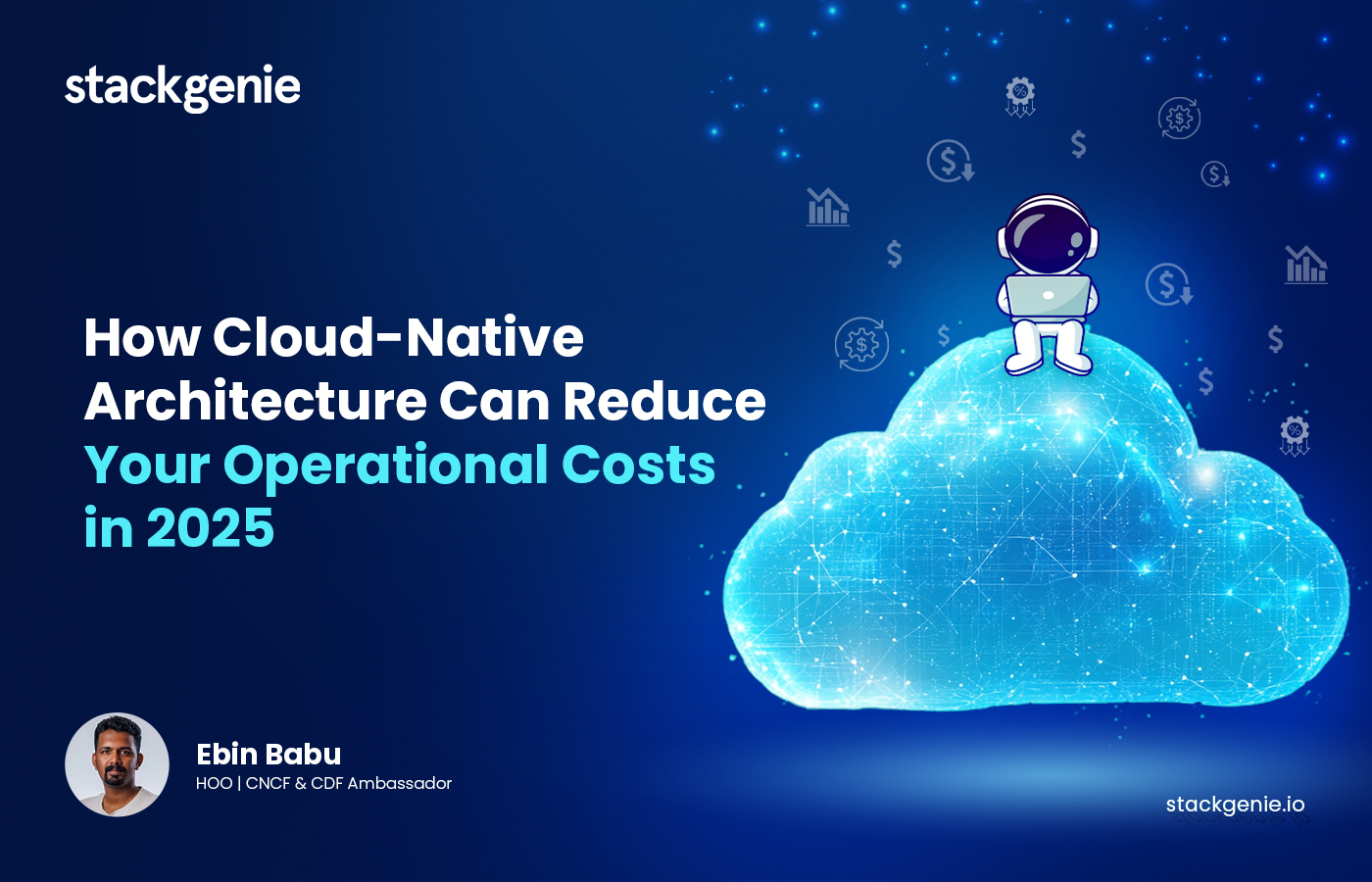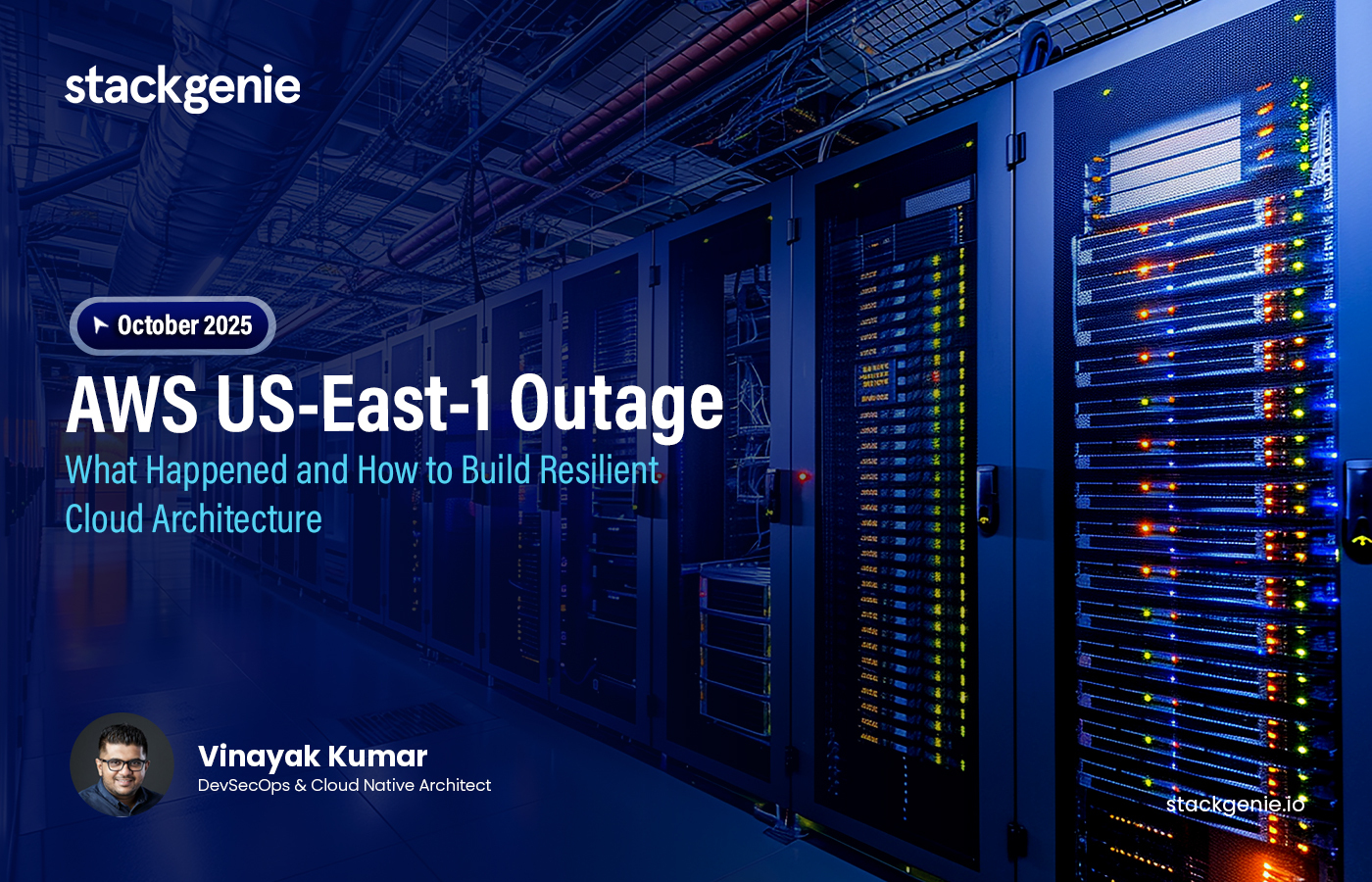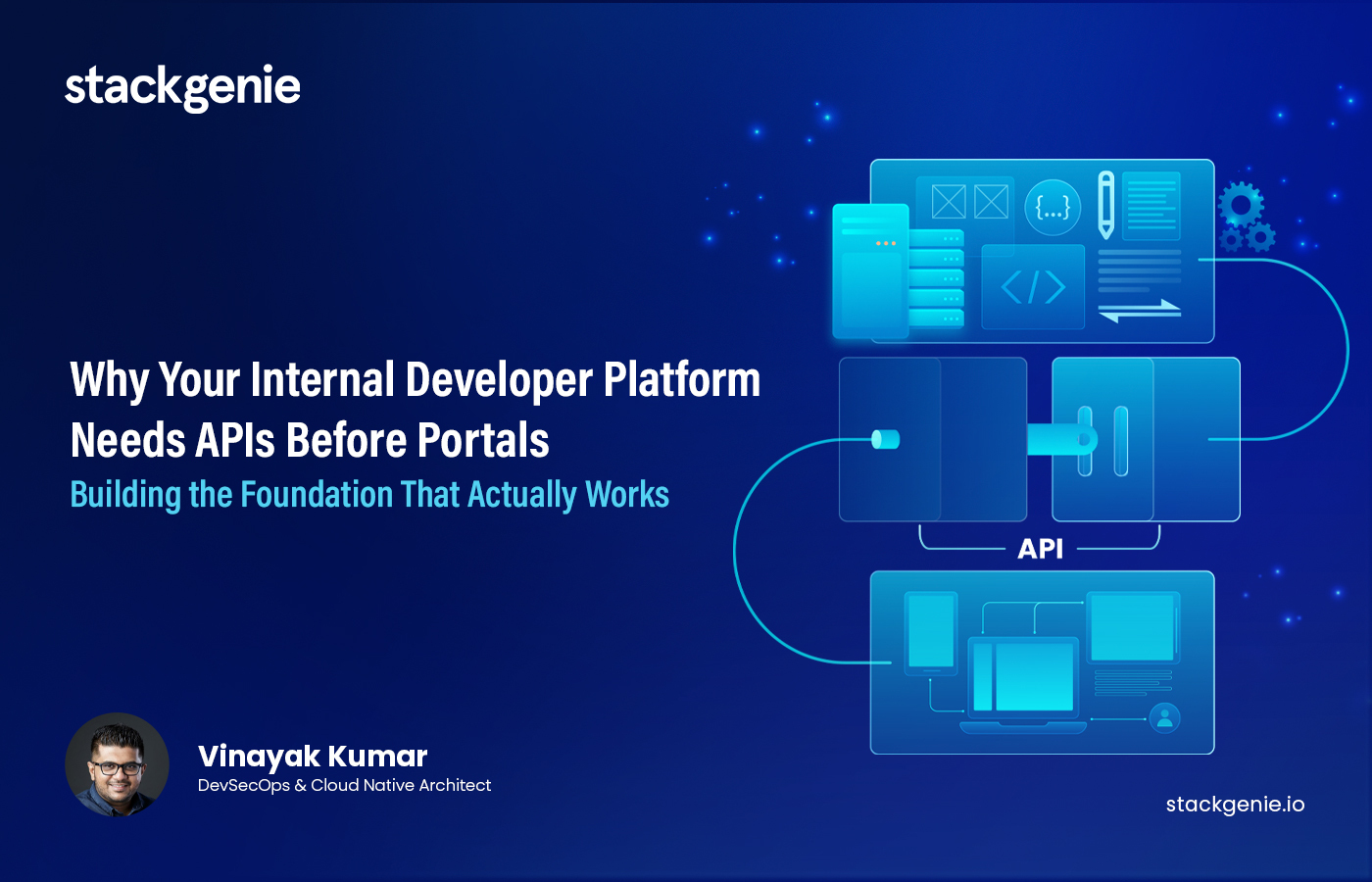Inside this article :
Introduction
In today’s competitive business landscape, operational efficiency isn’t just a goal—it’s a necessity. Cloud-native architecture has emerged as a game-changing approach for organizations looking to streamline operations and reduce costs significantly. But what exactly makes cloud-native so cost-effective, and how can your business benefit?
This comprehensive guide explores how adopting cloud-native principles can transform your IT spending while enhancing scalability, security, and development velocity. Whether you’re considering migration or looking to optimize your existing cloud infrastructure, understanding these cost-saving mechanisms can deliver substantial returns to your bottom line.
What is Cloud-Native Architecture?
Definition and Key Principles
Cloud-native architecture represents a modern approach to building and running applications that takes full advantage of cloud computing delivery models. Unlike traditional applications retrofitted for the cloud, cloud-native apps are specifically designed for cloud environments from inception.
The foundational principles of cloud-native architecture include:
- Microservices: Breaking applications into smaller, independently deployable services
- Containerization: Packaging applications with their dependencies for consistent deployment
- Declarative APIs: Using declarative programming to enhance automation
- DevOps practices: Implementing continuous integration and delivery pipelines
- Resilience by design: Building systems that can withstand failures without disruption
How It Differs from Traditional IT Infrastructure
Traditional infrastructure relies heavily on physical, on-premises hardware with significant upfront investments and maintenance costs. These systems typically require manual scaling, leading to overprovisioning to handle peak loads.
Cloud-native architecture fundamentally shifts this paradigm by leveraging:
- Dynamic resource allocation instead of static provisioning
- Consumption-based pricing models that eliminate idle capacity costs
- Automation that reduces manual operations and associated labor costs
- Platform-level resilience that minimizes downtime expenses
Key Components of Cloud-Native Architecture That Drive Cost Savings
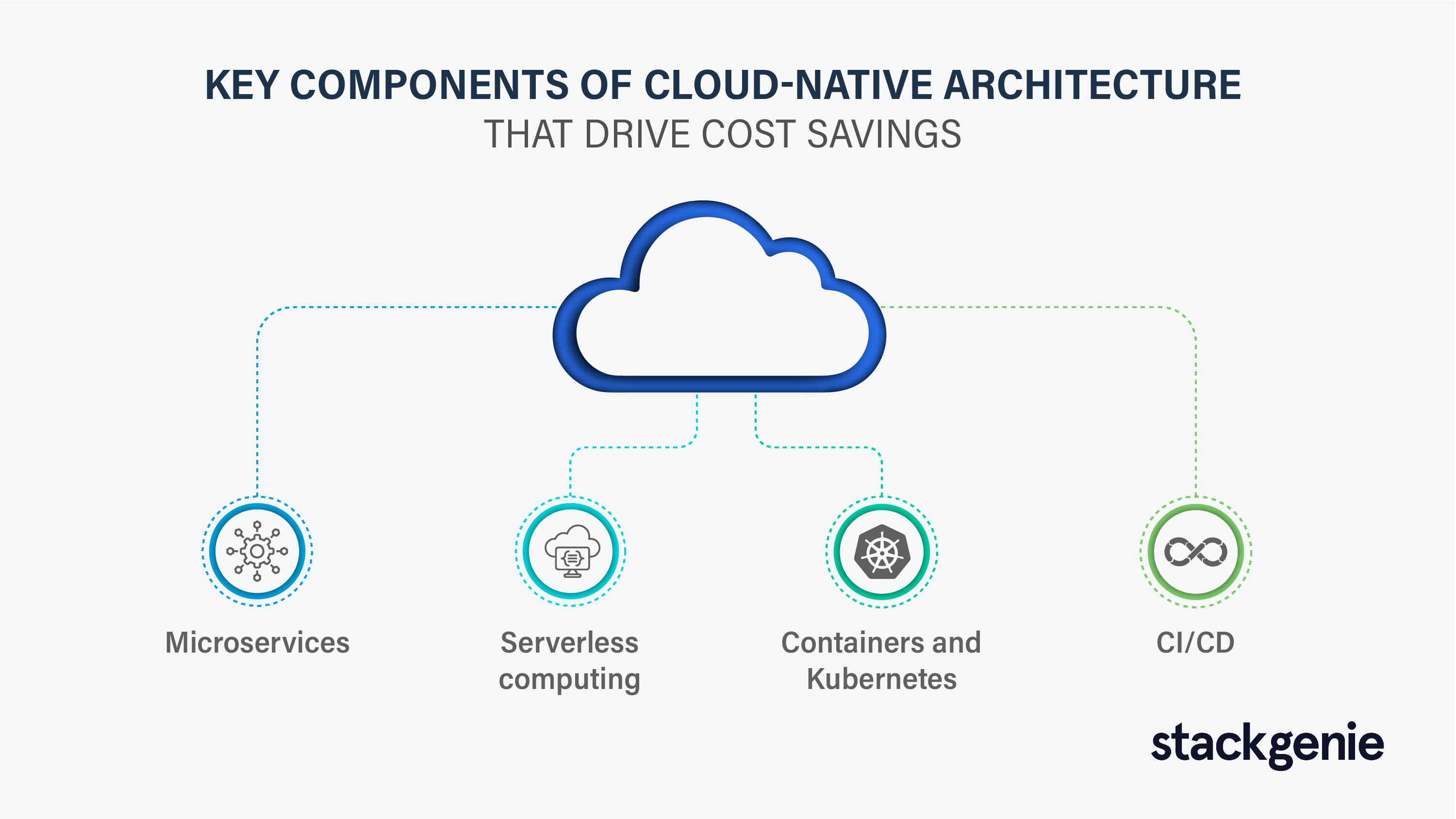 Microservices
Microservices
Microservices architecture breaks monolithic applications into smaller, purpose-built services that can be deployed, updated, and scaled independently. This approach yields significant cost advantages:
- Targeted scaling: Only scale the components experiencing high demand rather than the entire application
- Reduced resource consumption: Smaller, more efficient services consume fewer resources
- Improved fault isolation: Issues in one service don’t require system-wide restarts
- Optimized development: Teams can work independently, reducing costly coordination overhead
Containers and Kubernetes
Containers provide lightweight, consistent environments for application deployment, while Kubernetes orchestrates these containers at scale:
- Higher server density: Run more workloads on the same hardware
- Resource efficiency: Containers share OS resources, reducing overhead
- Automated orchestration: Kubernetes optimizes resource allocation and handles failures automatically
- Standardized deployments: Reduce environment-specific issues that lead to costly troubleshooting
Serverless Computing
Serverless computing allows organizations to run code without provisioning or managing servers:
- True pay-per-use: Billing based on actual execution time rather than reserved capacity
- Zero idle costs: No charges when functions aren’t running
- Automatic scaling: Seamlessly handles traffic spikes without manual intervention
- Reduced operational burden: No server management means fewer operational staff requirements
Continuous Integration & Continuous Deployment (CI/CD)
CI/CD pipelines automate the testing and deployment process:
- Faster time to market: Accelerate revenue generation from new features
- Reduced deployment failures: Automated testing catches issues before production
- Lower maintenance costs: Smaller, more frequent updates minimize the cost of change
- Operational efficiency: Automation reduces manual intervention and human error
5 Ways Cloud-Native Architecture Reduces Operational Costs
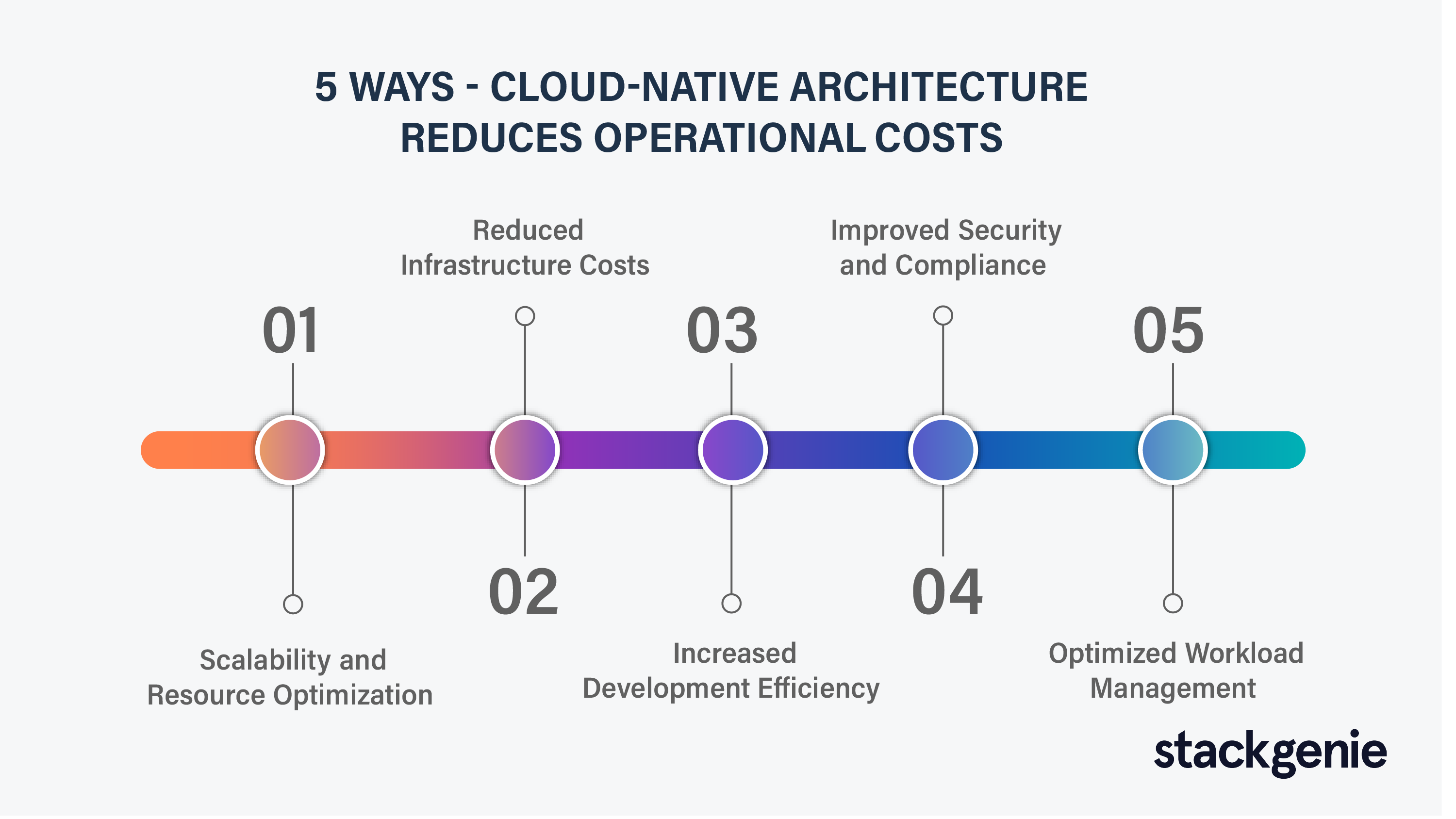 1. Scalability and Resource Optimization
1. Scalability and Resource Optimization
Cloud-native systems excel at matching resources to actual demand, eliminating waste:
Auto-scaling capabilities
Cloud-native applications automatically adjust resources based on real-time demand. During peak periods, resources scale up to maintain performance, then scale down during low-usage periods to minimize costs. This dynamic allocation can reduce resource expenditure by 30-45% compared to static provisioning.
Pay-as-you-go model
The consumption-based billing model ensures you only pay for what you use. This eliminates the traditional approach of provisioning for peak capacity, which often results in 60-70% of resources sitting idle during normal operations.
2. Reduced Infrastructure Costs
Physical infrastructure represents a significant expense that cloud-native architecture largely eliminates:
- Eliminated data center costs: No need for physical space, power, cooling, and security systems
- Reduced hardware investments: Cloud providers handle hardware procurement and upgrades
- Lower maintenance overhead: Provider-managed infrastructure reduces IT staff requirements
- Minimized obsolescence risk: No stranded investments in outdated hardware
Many organizations report 40-60% reductions in total infrastructure costs after migrating to cloud-native architectures.
3. Increased Development Efficiency
Cloud-native practices accelerate development while reducing costs:
- Streamlined deployment processes: Automated pipelines reduce deployment time from days to minutes
- Reduced downtime: Smaller, more frequent updates minimize disruption
- Improved developer productivity: Self-service infrastructure and standardized environments boost output
- Faster error resolution: Better observability and smaller change sets make troubleshooting more efficient
Studies show teams adopting cloud-native practices often achieve 2-3x higher developer productivity and 70% faster mean time to resolution (MTTR) for production issues.
4. Improved Security and Compliance
Security breaches and compliance failures can be extraordinarily expensive. Cloud-native architecture reduces these risks:
- Managed security services: Cloud providers invest billions in security, providing capabilities beyond what most companies could implement independently
- Automated compliance: Infrastructure-as-code enables consistent policy enforcement and automated compliance checks
- Reduced attack surface: Immutable infrastructure and frequent updates minimize vulnerability windows
- Centralized monitoring: Comprehensive visibility reduces the risk of undetected security issues
Organizations leveraging cloud-native security practices report up to 65% lower security incident costs and 45% reduced compliance management expenses.
5. Optimized Workload Management
Cloud-native technologies excel at intelligent workload distribution:
- Efficient resource utilization: Containerization and orchestration maximize hardware utilization
- Load balancing: Automatically distribute traffic to prevent bottlenecks
- Intelligent routing: Direct requests to optimal resources based on latency, cost, and other metrics
- Spot instance utilization: Take advantage of discounted excess capacity when available
These capabilities typically yield 25-40% improvements in overall resource efficiency.
Comparing Traditional vs. Cloud-Native Operational Costs
| Aspect | Traditional IT Infrastructure | Cloud-Native Architecture | Potential Savings |
| Hardware Costs | High upfront capital expenditure | No upfront costs; operational expenditure model | 40-60% |
| Maintenance | Dedicated IT team for hardware management | Provider-managed infrastructure | 30-50% |
| Scalability | Manual, expensive, requires overprovisioning | Automatic, dynamic, pay-per-use | 35-45% |
| Development Speed | Slow provisioning, manual deployments | Self-service, automated CI/CD | 50-70% faster |
| Downtime Costs | Frequent, often lengthy outages | Resilient design, minimal disruptions | 60-80% reduction |
| Security Expenses | Complex in-house security stack | Built-in, provider-managed security | 25-40% |
| Resource Utilization | Typically 15-35% of capacity | 65-80% of capacity | 2-3x improvement |
Challenges in Adopting Cloud-Native Architecture
While the cost benefits are substantial, organizations should be aware of potential challenges:
1. Initial Migration Costs
Transitioning to cloud-native architecture requires investment:
- Application refactoring: Redesigning monoliths for microservices
- Data migration: Moving and potentially restructuring data stores
- Infrastructure transition: Setting up new cloud environments
- Potential parallel operations: Running both old and new systems during migration
These costs typically range from 1.5-3x the monthly operational expense of the application but are recouped through long-term savings within 12-24 months.
2. Learning Curve for Teams
Cloud-native technologies require new skills:
- Container management: Docker, Kubernetes, service mesh
- Cloud provider expertise: AWS, Azure, GCP specific services
- DevOps practices: CI/CD, infrastructure as code
- Microservices patterns: Service discovery, distributed monitoring
Organizations must invest in training or hiring to build these capabilities, but this investment yields substantial efficiency gains.
3. Managing Multi-Cloud Environments
Many businesses leverage multiple cloud providers, which introduces complexity:
- Consistent governance: Applying uniform policies across providers
- Cost visibility: Tracking spending across disparate billing systems
- Skills diversification: Maintaining expertise in multiple platforms
- Integration challenges: Connecting services across cloud boundaries
However, effective multi-cloud strategies can yield 15-25% cost savings through provider competition and workload-specific placement.
Best Practices to Maximize Cost Savings
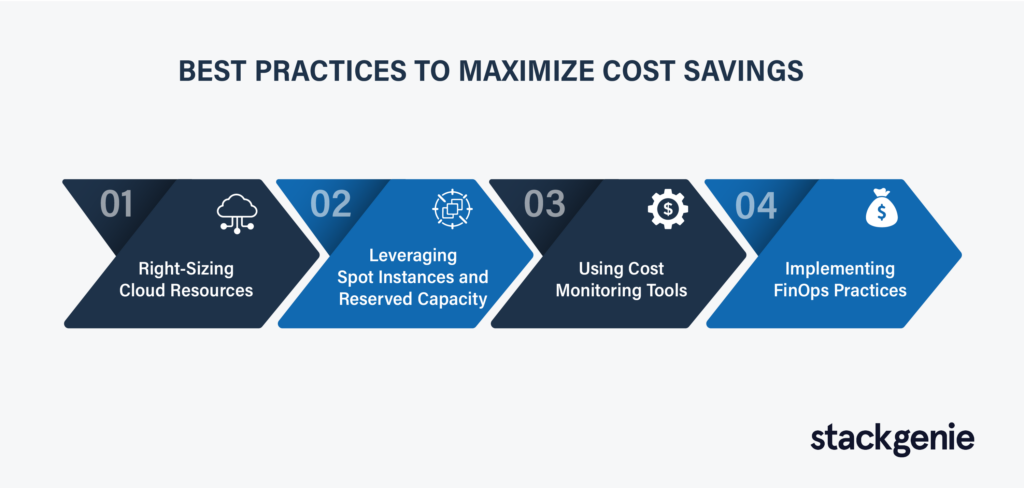 These proven strategies help organizations extract maximum value from cloud-native architectures:
These proven strategies help organizations extract maximum value from cloud-native architectures:
1. Right-Sizing Cloud Resources
Proper resource allocation is essential for cost efficiency:
- Conduct regular usage analysis to identify over-provisioned resources
- Implement automated right-sizing recommendations
- Use burstable instance types for variable workloads
- Establish governance protocols for resource provisioning
Organizations that implement rigorous right-sizing can reduce cloud spending by 15-30%.
2. Leveraging Spot Instances and Reserved Capacity
Strategic capacity planning drives significant savings:
- Spot Instances: For non-critical, interruptible workloads (60-90% savings)
- Reserved Instances: For predictable, steady-state workloads (40-75% savings)
- Savings Plans: For stable usage across multiple services (up to 72% savings)
- Capacity Reservations: For critical workloads with predictable patterns
A balanced portfolio approach typically yields 30-50% overall infrastructure cost reduction.
3. Using Cost Monitoring Tools
Visibility is essential for cost control:
- Implement real-time cost monitoring dashboards
- Set up budget alerts and anomaly detection
- Establish tagging strategies for cost allocation
- Perform regular cloud spend reviews
Organizations with mature cloud financial operations (FinOps) practices achieve 20-35% higher cost efficiency than those without.
4. Implementing FinOps Practices
Cloud Financial Operations (FinOps) brings financial accountability to cloud spending:
- Establish clear ownership of cloud resources
- Implement chargeback or showback mechanisms
- Create financial incentives for cost optimization
- Build a culture of cost awareness
Mature FinOps practices typically yield 20-30% savings beyond technical optimizations alone.
Case Studies: Companies That Reduced Costs with Cloud-Native Architecture
Netflix: Scaling Efficiently with Microservices
Netflix’s migration to a cloud-native microservices architecture revolutionized their operational efficiency:
- Result: 8x reduction in streaming outages
- Cost Impact: Ability to handle 10x user growth with only 2x cost increase
- Key Strategy: Breaking monolithic applications into hundreds of microservices that scale independently
Capital One: Banking on Cloud-Native Savings
Capital One became the first major bank to go all-in on cloud-native architecture:
- Result: Closed all data centers by 2020
- Cost Impact: 40% reduction in technology infrastructure costs
- Key Strategy: Containerization and serverless adoption for both legacy and new applications
Airbnb: Optimizing Resources with Kubernetes
Airbnb’s transition to Kubernetes transformed their resource utilization:
- Result: Improved CPU utilization from 40% to 80%
- Cost Impact: 30% reduction in infrastructure spending
- Key Strategy: Advanced orchestration and autoscaling to handle seasonal demand efficiently
Future of Cloud-Native Architecture and Cost Efficiency
The cost benefits of cloud-native architecture will continue to evolve:
AI-Driven Cloud Optimization
Machine learning will revolutionize cloud cost optimization:
- Predictive scaling: AI will anticipate demand patterns before they occur
- Automated troubleshooting: Reduce costly downtime through anomaly detection
- Resource rightsizing: AI-driven recommendations for optimal configurations
- Workload placement optimization: Automatic determination of the most cost-effective execution environment
Serverless Expansion
Serverless computing will expand to more use cases:
- Serverless containers: Bringing container flexibility with serverless economics
- Stateful serverless: Expanding beyond stateless functions to more complex applications
- Edge serverless: Deploying functions at network edge for improved performance and reduced data transfer costs
FinOps Integration
Cloud financial management will become deeply integrated with development:
- Shift-left cost awareness: Developers will see cost implications during coding
- Cost-based automation: Systems will automatically optimize based on financial parameters
- Value-based metrics: Measuring cost per transaction, user, or business outcome
Conclusion
Cloud-native architecture represents a fundamental shift in how applications are built and deployed—one that delivers substantial operational cost reductions. By leveraging microservices, containers, serverless computing, and automated CI/CD pipelines, organizations can dramatically lower infrastructure costs while improving scalability, security, and development efficiency.
While the transition requires investment and organizational change, the long-term benefits significantly outweigh the initial costs. Companies that successfully adopt cloud-native approaches typically achieve 30-50% overall operational cost reductions while simultaneously gaining agility and resilience.
As cloud-native technologies continue to mature, organizations that embrace these principles will enjoy sustainable competitive advantages through superior cost structures and greater technological capabilities. For businesses looking to optimize their IT spending while enhancing performance, cloud-native architecture offers a compelling and proven path forward.
FAQs
1. How much can a company realistically save by moving to cloud-native architecture?
Most organizations achieve 30-50% reduction in total IT operational costs after fully adopting cloud-native principles. However, results vary based on current infrastructure, application complexity, and implementation approach. The highest savings typically come from organizations with significant on-premises infrastructure and seasonal workloads.
2. What are the hidden costs of cloud-native migration that companies should anticipate?
Common hidden costs include:
- Training and skill development (typically 5-10% of project budget)
- Temporary parallel environments during migration
- Potential application refactoring or rewriting
- Third-party tools for monitoring, security, and cost management
- Potential data transfer charges between services
Successful migrations budget for these costs in advance rather than treating them as surprises.
3. Is cloud-native architecture suitable for small businesses with limited IT resources?
Yes, small businesses often benefit the most from cloud-native architecture. The pay-as-you-go model eliminates large capital expenditures, while managed services reduce the need for specialized IT staff. Cloud-native approaches allow small businesses to access enterprise-grade technology without enterprise-level investment, effectively leveling the playing field with larger competitors.
4. How does serverless computing specifically help reduce operational costs?
Serverless computing eliminates idle capacity costs completely by charging only for actual execution time, often measured in milliseconds. This fine-grained billing can reduce costs by 60-80% for appropriate workloads, particularly those with variable or unpredictable traffic patterns. Additionally, serverless eliminates all server management overhead, reducing operational staff requirements.
5. What tools are most effective for monitoring and optimizing cloud-native spending?
Effective cloud cost management typically involves multiple tools:
- Native cloud provider tools: AWS Cost Explorer, Azure Cost Management, Google Cloud Billing
- Third-party platforms: CloudHealth, Cloudability, Apptio Cloudability
- Open-source options: Kubecost (for Kubernetes), OpenCost
- FinOps platforms: CloudZero, Harness
The most effective approach combines automated monitoring tools with regular human review and clear cost accountability within the organization.
